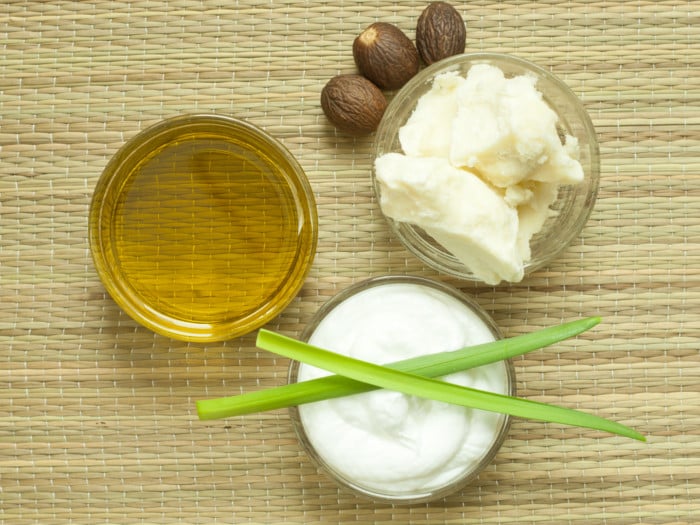The use of shea oil is quite popular with those who want to protect their skin and face, particularly if they typically use shea butter or other natural moisturizers.
What is Shea Oil?
Shea oil is one of the byproducts of shea butter production, which is a popular nut butter derived from the nuts of the shea tree, scientifically known as Vitellaria paradoxa. While it contains many of the same nutrients and active compounds, the butter tends to have higher levels of stearic acid, which gives it some of the thickness and texture. Aside from stearic acid, the oil has many of the same fatty acids as shea butter, including capric, caprylic, lauric, palmitic, cinnamic, oleic, and linoleic acids. The oil also contains various vitamins and antioxidants that can have significant effects on the body. [1]
In terms of color, the oil has a slightly yellow color, similar to shea butter, but it doesn’t have the same protective effects, due to its consistency. Therefore, if you want to apply more of a shield for your skin, shea butter may be a better option, but there are plenty of great uses for shea oil as well.

Shea oil is a natural hair & skin super-food derived from African shea nut. Photo Credit: Shutterstock
| Serving Size : | |
|---|---|
| Nutrient | Value |
| Energy | 884 |
| Energy [kJ] | 3699 |
| Total lipid (fat) [g] | 100 |
| Fatty acids, total saturated [g] | 46.6 |
| 8:0 [g] | 0.2 |
| 10:0 [g] | 0.2 |
| 12:0 [g] | 1.3 |
| 14:0 [g] | 0.1 |
| 16:0 [g] | 4.4 |
| 18:0 [g] | 38.8 |
| Fatty acids, total monounsaturated [g] | 44 |
| 16:1 [g] | 0.1 |
| 18:1 [g] | 43.5 |
| Fatty acids, total polyunsaturated [g] | 5.2 |
| 18:2 [g] | 4.9 |
| 18:3 [g] | 0.3 |
| Phytosterols [mg] | 357 |
| Sources include : USDA [2] | |
Shea Oil Benefits
The most notable benefits of shea oil include its ability to do the following:
- Moisturize the skin
- Reduce inflammation
- Straighten the hair
- Eliminate wrinkles
- Treat acne
- Reduce congestion
- Prevent cracked heals
Moisturizer
Many of the volatile acids in this oil are able to be absorbed by the skin quite easily, helping to trap moisture and keep your skin healthy and your cells functioning properly. [3]
Inflammation
If you are suffering from pain in your joints or the symptoms of an inflammatory skin condition, you can apply a few drops of this oil, and the anti-inflammatory activity of oleic, palmitic, and stearic acid will help to reduce pain. [4]
Hair Care
If you apply this oil to frizzy or unruly hair, you can keep your hair straight, making it much easier to style your hair and boost luster. [5]
Antioxidants
The antioxidants in this oil are excellent for any form of oxidative stress or inflammation, meaning that it can help prevent free radical activity in the body, including slowing the onset of wrinkles on the face and reducing the risk of developing chronic disease. [6]
Acne
With good levels of vitamin C, vitamin A, and antioxidants, this oil can help to clear up acne symptoms. Shea oil, being a non-comedogenic, can also help eliminate the blockage in the pores by improving the balance of moisture and oil on your skin. [7]
Congestion
Small amounts of this oil rubbed near the nose or temples can help to reduce congestion in the face. This is both due to the topical absorption and the aromatic compounds acting as an expectorant. [8]
Cracked Heels
If you spend a lot of time on your feet, you may have dry, cracked heels, but the moisturizing and healing properties of this oil can solve that annoying condition. [9]
Shea Oil Uses
There are a number of excellent uses for shea oil, including as a massage oil, facial oil, body oil, and hair oil.
- Massage: As a massage oil, only 5-10 drops are needed and can be rubbed into the back, sore muscles or temples for fast relief of soreness in the muscles. This is due to the rapid absorption, vitamins, and antioxidants present in the oil.
- Face: You can apply this oil to patches of inflammation on the face, as well as for bags under the eyes and wrinkles. Applying only a few drops, along with a carrier oil, can be enough for good results when done daily for 1-2 weeks.
- Body: If you have rough patches of skin or inflammation, rub a few drops into the area once a day for a week to see results.
- Hair: Mixing some of this oil into your shampoo and conditioner can lead to a healthier scalp, fewer split ends, and less unwanted hair loss.
Difference Between Shea Oil & Shea Butter
There are few differences between the two, shea oil and shea butter, let us discuss them.
- Shea butter is slightly thicker, largely due to how it’s processed, and the presence of higher levels of a certain thickening agent, stearic acid.
- Shea butter is more widely available than the oil.
Precautions
Some people do experience topical inflammation when using this oil, particularly if they are using excessive quantities. When using it for the first time, apply a small amount to a limited area and watch for any negative side effects.
